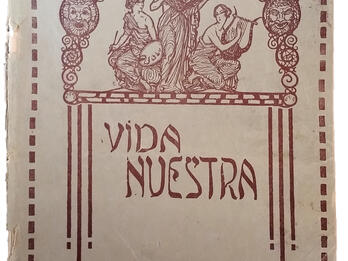The Spaniolische (Sephardic) Woman
We have been implored to print the following letter:
Dear Mrs. Bernadzikowska-Belović,
I am an eager reader of the Bosnische Post and, especially, of your short feature pieces and articles, which are my favorite reading matter. In issue no. 281 of the Bosnische Post, published on the tenth of this month, I read “The South Slav Woman in Politics.” There was one passage in it that has prompted me to make some brief remarks. It goes as follows:
The Spaniolish [woman] is only interested in her husband’s or brother’s business affairs just as for the sake of business she has learned the languages of her fellow inhabitants. But apart from that, she remains with all her opinions stuck in the Middle Ages just as with her Spanish-Slavic dialect, which no modern Spaniard can understand.
The fact that the Spaniolish woman in Bosnia is hungry for knowledge and that she feels the need to learn several languages is unfortunately proven by the neglect of our mother tongue. We do everything in our power to acquire proficiency in German and Croatian—not for the sake of a husband’s business but simply to comply with the requirements for taking part in the general culture in our young country. And as to the countless Spaniolish women engaging in commerce whom one sees today, this is just a phenomenon that was sadly born out of war.
With regard to their opinions, Spaniolish [women] are already very far away from the Middle Ages. Is there any part of the population more appreciative of the salutary work done by the bearers and transmitters of culture among us than the Spaniolish [woman] has been since just a few years after the onset of the [Austrian] occupation? She has the talent to easily cuddle up to every change in circumstances. Who, for example, is more adaptive to fashion trends (not a praiseworthy character trait, for that matter) than the Spaniolish? No, we are not women with medieval views anymore. At most one can accuse us of a small-town mentality, but that applies to all women at the geographical periphery alike. We do not resemble the Sephardim of Amsterdam, of course not!
Finally, I would like to touch on the question of the Judeo-Spanish Language, “the Bosnian-Spanish-Slavic dialect which no modern Spaniard can understand.” Yes, we do employ here and there some Turkish loanwords, but this is done by the “Švabo” [Swabian, i.e., German] as well, who after having lived a couple of months in Bosnia already has a penchant for saying: “I am now going to the čaršija,” or “there is a ćuprija there.”1 The Serbs and Croats used to say: “kijamet,” “ćesatluk,” “selamet,”2 and so on, even though they, after all, do speak their “literary language” and should have no need for Turkish loanwords! Well, this is, it has to be stressed, simply the custom here in the region. In 1910, a famous Spanish writer called Manuel Manrique de Lara spent several months here.3 This Madrid-born man was tasked by the Academia cientifica to collect old Spaniolish musical romances. I had the opportunity to collect some songs and proverbs for him and to listen to his opinion on our idiom. He said that the Sephardic were not speaking Castellano, obviously, but that theirs was a softer and more purely Romance language, whereas Castellano had a strong Moorish-Arabic note. He could not stop expressing admiration for certain expressions of ours, just like he praised songs, proverbs, and figures of speech. In short: a modern Spanish man of letters did not just understand us, but he has returned from this small Sephardic community of Sarajevo with literary treasures back to Spain.
Notes
Serbo-Croatian: čaršija, from Ottoman Turkish: çarş—market; Serbo-Croatian: ćuprija, from Ottoman Turkish Köprü—bridge.
Serbo-Croatian: kijamet, from Ottoman Turkish: kiyamet—literally “doom’s day,” but more often, “a storm”; Serbo-Croatian: ćesatluk, from Ottoman Turkish: kesatlık—poverty, stagnation; Serbo-Croatian: selamet, from Ottoman Turkish selamet—salvation.
Manuel Manrique de Lara (1863–1929), a musicologist and composer who visited the Balkans to collect romances in 1911 (not 1910, as written here). Greatly impressed by this meeting, Papo began her own project collecting Sephardic romanceros, which were later published in a study by the Ladino linguistic scholar Kalmi Baruh (1896–1945). Papo later adapted her research to theater as a way to distribute this folkloric research, much like S. An-ski’s The Dybbuk.
Credits
Laura Papo, “The Spaniolish [Sephardic] Woman,” trans. Michael Hasin and annot. Avishag Ben Shalom (unpublished). Originally published in German as “Die Spaniolische Frau,” Bosnische Post, Dec. 17, 1916. Used with permission of Michael Hasin and Avishag Ben Shalom.
Published in: The Posen Library of Jewish Culture and Civilization, vol. 7.



